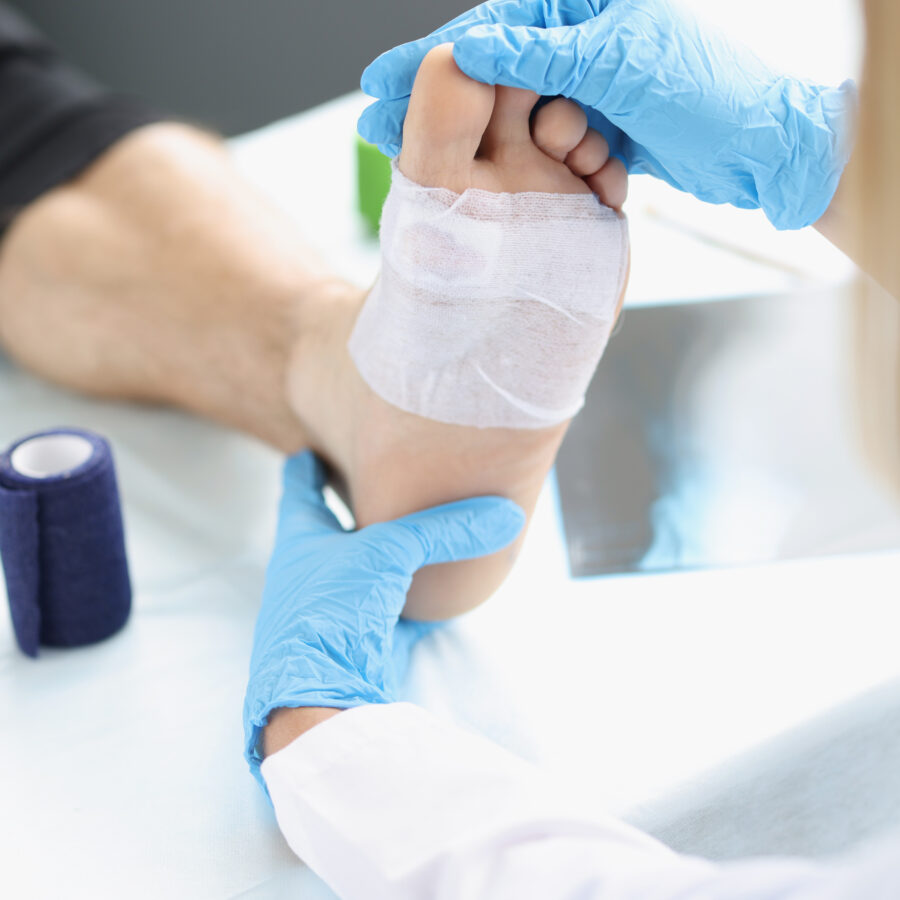What are wounds?
A wound can be described as a disturbance or injury to the skin and soft tissue beneath it.
An Acute (meaning sudden) wound is typically related to trauma (laceration, scrape, bite, stab), a burn, or surgery.
A chronic (meaning persistent) wound typically begins as acute, but healing is delayed. There are several reasons for delayed wound healing including infection, abnormal circulation, diabetes, malnutrition, advanced age, smoking, immunosuppressive therapy, and immobility. Sometimes a patient has more than one of these factors contributing to delayed wound healing.
What are some common types of wounds?
- Arterial or Ischemic ulcer
- Venous ulcer
- Diabetic ulcer
- Pressure-induced injury
- Neuropathic ulcer
- Ulcers associated with malignancy or cancer
- Surgical wounds
- Infected wounds
What are the essential steps to optimize healing?
- Circulation (blood flow): If you have an abnormality of either your arteries, veins, or both, this can negatively impact wound healing.
- Infection: Overgrowth of bacteria in or around the wound can lead to an infection.
- Edema (swelling): Particularly in the legs, can interfere with a wound’s ability to heal.
- Non-viable tissue: Dead cells in the wound can build up on the surface and prevent the new healthy tissue from developing.
- Pressure: Patients that have limited mobility are at risk of developing a pressure injury.
- Nutrition: Adequate nutrition is vital forwound healing.
- Other factors impacting wound healing include diabetes, kidney function, autoimmune disorders, cardiac disease, nicotine use, chronic pain, advanced age, malignancy, and socioeconomic factors such as financial restraints and access to care.
How does a wound heal?
An acute wound will progress through the 4 steps of healing over 2-4 weeks, barring any complications.
The first step to healing occurs almost immediately. The body reacts with a process called hemostasis, which slows blood flow to the area. Then, small blood cells called platelets are activated at the site of the wound causing clots to stop the bleeding
*Patients on anticoagulation medications (i.e. blood thinners), can experience prolonged bleeding.
The second step of healing is the inflammatory phase. White blood cells respond to the wound to fight infection and remove damaged cells. Swelling can occur at this time. This phase can begin 1-14 days after the wound occurs.
The 3rd step is when the wound begins to rebuild. This is called the proliferative phase. New cells combine to form granulation tissue which replaces old wound debris with healthy tissue. A new network of blood vessels develops to improve circulation to the wound bed. As this occurs, healthy cells begin pulling the wound edges together.
Finally, the remodeling phase is when the new tissue strengthens, and old cells die. This typically begins about 21 days after the wound forms and can take up to a year.
What are the treatments for wounds?
Arterial Revascularization
When wounds are not getting enough blood flow to heal, vascular surgeons perform endovascular interventions or surgical bypasses to improve circulation.
Venous Ablation for Venous Ulcerations
An intervention to correct to normal blood return from the lower leg and decrease leg swelling. This rapidly speeds up healing of long-term wounds due to venous congestion.
Debridement
Removal of non-viable tissue and bacteria overgrowth on the surface of the wound can be accomplished with mechanical debridement. There are also wound dressings that can be applied to help break down this accumulation.
Control of Edema
Control of edema for swelling and skin breakdown optimizes the environment for healing. Leg elevation allows gravity to help, and activity improves the muscle pump. Compression can be accomplished with stockings, wraps and pneumatic pumps.
Skin Substitutes
Human, animal or synthetic tissue can be used on wounds and burns to promote healing.
Negative Pressure Wound Therapy (wound vac)
A dressing that consists of foam or gauze is placed into the wound. It is then covered with an occlusive dressing that is attached to a device that, when turned on, provides gently suction to the wound.
Hyperbaric Oxygen Therapy
A treatment that involves breathing in 100% oxygen in a pressurized environment called a hyperbaric chamber.
